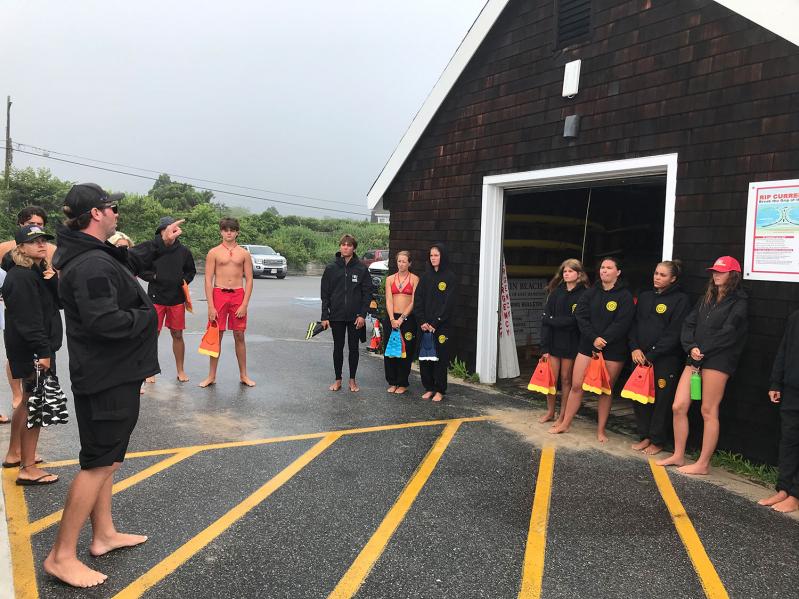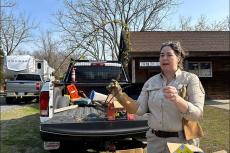It’s July, and in the dry East Hampton fields, the corn is knee high. In the village, a blue Gucci truck (of course) hands out espresso in front of the Maidstone Hotel. About a mile south at Main Beach, the vibe is different as lifeguards show up for work.
It’s not an ideal beach day. The rain just stopped and onshore winds beat on sloppy gray and brown waves that rush to the shore like a panicking crowd heading for an exit. There is no order. The horizon is blurred by fog and sea spit.
A strapping teenager saunters past the Beach Hut concession at the pavilion in shorts and a bucket hat. A girl jumps out of a car wearing a black sweatsuit with the word “lifeguard” written in yellow letters on her back. They look almost like children, but they’re part of a team that saves lives.
At 9 a.m. they’re gathered around Drew Smith, the village’s chief lifeguard, and Lucy Emptage, his newly-promoted assistant chief, who are discussing conditions and communicating assignments for the day. The guards are assembled in five teams of four, which represent the lifeguard stands staffed by the village: three at Main Beach, one at Georgica, and another at Two Mile Hollow.
Words you might not expect to hear, like “Narcan,” are tossed around. The guards are also trained to identify victims with spinal injuries, how to move them, and what to do if a beachgoer has a diabetic emergency, among other medical events. (“We’re the first line between the E.M.S. and the Police Department. We have to be versed in everything,” Mr. Smith explained later.) They all know CPR and basic first aid. They must pass written and physical exams and complete 24 hours of ocean training before they obtain their Surf Level One Certification, which allows them to don the red swim trunks or bikinis of the East Hampton Village Lifeguards and get to the business of saving lives.
And for the village, the beach is business. From August 2023 through last week, it brought $2,364,093 into village coffers, the vast majority, $1,971,545 coming from seasonal parking passes. “Keeping our beaches clean, safe and friendly for our residents and guests has been and is a priority for my administration,” said Mayor Jerry Larsen. “My team’s efforts have really paid off, as Main Beach is once again, one of the top 10 beaches in the United States.”
“The current is moving today,” Mr. Smith tells the guards, which to a non-lifeguard seems a massive understatement. “Any of the stands need anything?”
“A garbage truck,” comes one reply. Indeed, as the guards meet, younger beach staff are searching for trash, picking it up, and placing it in white buckets.
When Mr. Smith tells them, “We’re going to do a drift today,” the guards are thrilled, which seems surprising on this red flag day, with four-to-six-foot waves. “We love this stuff,” admits J.P. Amaden, a lifeguard. A minute later, the 20 guards are running westward down the beach with flippers before jumping into the white mess.
Ms. Emptage drives a Polaris General along the beach, watching the progress of the guards. In front of the Main Beach Pavilion, a group of 17 yogis are being led through a series of movements, seemingly oblivious to the 20 heads sweeping past them in the waves. The current is so strong that it takes only five minutes before the lifeguards are exiting the water, 300 yards east of where they entered.
One girl, another lifeguard, approaches the Polaris. During the drift, she got tossed by a wave hard enough that her head hit the sand. She says she’s fine, a little dizzy, but she sits out the next drift. Later, she goes home early. (Mr. Smith says she was examined by a doctor and didn’t suffer a concussion.) Being a lifeguard is dangerous work.
Amazingly, the team does two more drifts. In the first 30 minutes of their workday, they’ve entered turbid waters, and swam and run a half mile along the beach. In the next 30 minutes, they’ll carry everything they need down to their stands so the beach can open for swimming at 10 a.m. They go home at 5 p.m.
“It’s important for them to feel the power of the waves, so if we do have a rescue, they know what they’re up against,” says Ms. Emptage, 24. “Sometimes it’s deceiving how heavy the waves are, and the strength of the rips.” Mr. Smith points out three well-known rips. “If you make a save on a day like today, you’re going to earn it,” he says. Simple saves are known as “plucks,” as in you’ve plucked someone from the water. “Every time you go out, you’re planning on coming back in with someone. Lifeguards have to account not just for themselves, but for themselves and a victim.”
After the second drift a guard, excited, calls to Ms. Emptage, “Lucy! I caught a bomb!” During the day, Ms. Emptage and Jay Brunner, another assistant chief, may drive the Polaris to the “outer beaches” to check in on the stands. Each stand is also equipped with radios keeping the guards in contact with their supervisors.
“We work in a glass house,” said Mr. Smith. “The public may see one guard on the stand and three below and think only the guard in the stand is working. What they don’t understand is that the guard in the stand is the quarterback and those three ‘down guards’ are the ones who will be making the saves. They’re on call. You never know when the next emergency is.”
“The thing I love about the village beaches is how family oriented they are,” says Ms. Emptage. “Either people are actually related, or they just treat each other as family.”
“The biggest change over the last few years is we’ve moved from ‘rescue-based lifeguarding’ to ‘preventative lifeguarding,’ said Mr. Smith. “Ideally, we make a save without ever entering the water, just by educating people. We’re surrounded by water on the East End. Not just the ocean, but a lot of the houses have pools.”
The group exits the water for the last time. They’re all smiles. “The confidence is there with every guard, which is what we want,” said Ms. Emptage. The yoga class breaks up. The lifeguard stands are being stocked. Two female guards are carrying a medical kit, rescue torpedoes, and a torniquet to their stands.
“For shark bites,” says Mr. Smith. “I’d rather have them and never have to use them.”




